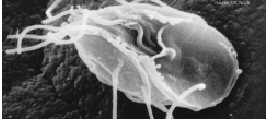|
Copromyxa
''Copromyxa'' is a genus of Amoebozoa Amoebozoa is a major taxonomic group containing about 2,400 described species of amoeboid protists, often possessing blunt, fingerlike, lobose pseudopods and tubular mitochondrial cristae. In traditional and currently no longer supported classi ... in the eukaryotic supergroup Amoebozoa. It currently includes 2 species, the sorocarpic (aggregatively fruiting) amoeba ''Copromyxa protea'' and the non-sorocarpic amoeba ''Copromyxa (=Hartmannella) cantabrigiensis''. There is also a species ''Copromyxa arborescens,'' which is a synonym of ''C. protea''. References Amoebozoa genera {{Amoebozoa-stub ... [...More Info...] [...Related Items...] OR: [Wikipedia] [Google] [Baidu] |
Hartmannellidae
The Hartmannellidae are a family of amoebozoa, usually found in soils. When active they tend to be roughly cylindrical in shape, with a single leading pseudopod and no subpseudopodia. This form somewhat resembles a slug and as such they are also called limax amoebae. Trees based on rRNA show the Hartmannellidae as usually defined are paraphyletic In taxonomy (general), taxonomy, a group is paraphyletic if it consists of the group's most recent common ancestor, last common ancestor and most of its descendants, excluding a few Monophyly, monophyletic subgroups. The group is said to be pa ... to the Amoebidae, which may adopt similar forms. References External links Amoebozoa families {{Amoebozoa-stub ... [...More Info...] [...Related Items...] OR: [Wikipedia] [Google] [Baidu] |
Amoebozoa
Amoebozoa is a major taxonomic group containing about 2,400 described species of amoeboid protists, often possessing blunt, fingerlike, lobose pseudopods and tubular mitochondrial cristae. In traditional and currently no longer supported classification schemes, Amoebozoa is ranked as a phylum within either the kingdom Protista or the kingdom Protozoa. In the classification favored by the International Society of Protistologists, it is retained as an unranked " supergroup" within Eukaryota. Molecular genetic analysis supports Amoebozoa as a monophyletic clade. Modern studies of eukaryotic phylogenetic trees identify it as the sister group to Opisthokonta, another major clade which contains both fungi and animals as well as several other clades comprising some 300 species of unicellular eukaryotes. Amoebozoa and Opisthokonta are sometimes grouped together in a high-level taxon, variously named Unikonta, Amorphea or Opimoda. Amoebozoa includes many of the best-known a ... [...More Info...] [...Related Items...] OR: [Wikipedia] [Google] [Baidu] |
Tubulinea
The Tubulinea are a major grouping of Amoebozoa, including most of the more familiar amoebae genera like ''Amoeba'', '' Arcella'', '' Difflugia'' and '' Hartmannella''. Characteristics During locomotion most Tubulinea have a roughly cylindrical form or produce numerous cylindrical pseudopods. Each cylinder advances by a single central stream of cytoplasm, granular in appearance, and has no subpseudopodia. This distinguishes them from other amoeboid groups, although in some members this is not the normal type of locomotion. Classification This class was anticipated by some biologists like Jahn, who grouped all amoebae with granular pseudopodia together, but most split the lobose amoebae into testate Testacealobosia and naked Gymnamoebia. These latter are polyphyletic, but molecular trees by Bolivar ''et al.'' identified a core monophyletic subgroup. Subsequent studies showed the testate lobose amoebae belong to the same group, which was thus renamed Lobosea ''sensu stricto'' or ... [...More Info...] [...Related Items...] OR: [Wikipedia] [Google] [Baidu] |
Euamoebida
The Tubulinea are a major grouping of Amoebozoa, including most of the more familiar amoebae genera like '' Amoeba'', '' Arcella'', '' Difflugia'' and ''Hartmannella''. Characteristics During locomotion most Tubulinea have a roughly cylindrical form or produce numerous cylindrical pseudopods. Each cylinder advances by a single central stream of cytoplasm, granular in appearance, and has no subpseudopodia. This distinguishes them from other amoeboid groups, although in some members this is not the normal type of locomotion. Classification This class was anticipated by some biologists like Jahn, who grouped all amoebae with granular pseudopodia together, but most split the lobose amoebae into testate Testacealobosia and naked Gymnamoebia. These latter are polyphyletic, but molecular trees by Bolivar ''et al.'' identified a core monophyletic subgroup. Subsequent studies showed the testate lobose amoebae belong to the same group, which was thus renamed Lobosea ''sensu stricto'' ... [...More Info...] [...Related Items...] OR: [Wikipedia] [Google] [Baidu] |
University Of Arkansas
The University of Arkansas (U of A, UArk, or UA) is a public land-grant research university in Fayetteville, Arkansas. It is the flagship campus of the University of Arkansas System and the largest university in the state. Founded as Arkansas Industrial University in 1871, classes were first held on January 22, 1872, with its present name adopted in 1899. It is noted for its strong programs in architecture, agriculture (particularly animal science and poultry science), communication disorders, creative writing, history, law (particularly agricultural law), and Middle Eastern studies, as well as for its business school, of which the supply chain management program was ranked the best in North America by Gartner in July 2020. In a 2021 study compiled by DegreeChoices and published by Forbes, the University of Arkansas ranked 13th among universities with the most graduates working at top Fortune 500 companies. The university campus consists of 378 buildings spread across of lan ... [...More Info...] [...Related Items...] OR: [Wikipedia] [Google] [Baidu] |

